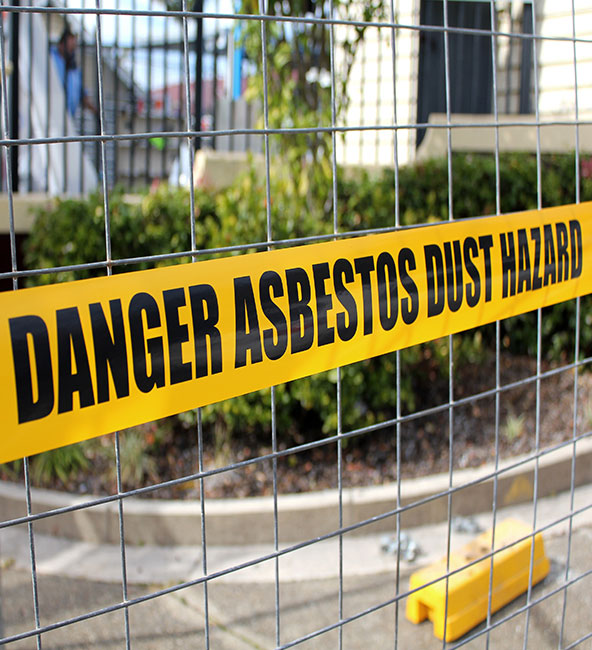Asbestos Symptoms and Treatment / Síntomas de asbesto
Asbestos exposure can lead to many diseases, including cancer.
Asbestos is a known human carcinogen, capable of causing serious medical conditions up to and including cancer. However, asbestos-related diseases are different from other illnesses.


Symptoms of asbestos illness can take decades to appear.
Asbestos illnesses have a long latencia. That means people who have worked with or lived around asbestos may not experience any symptoms for decades after their first exposure.
Since the symptoms of asbestos exposure are often similar to the symptoms of other, less serious conditions, many people do not realize or understand that they have a life-threatening asbestos-related illness. |
Where Asbestos is Found
Between the 1920s and 1970s, asbestos could be found almost everywhere. Common asbestos products included:
- Piezas de automóviles, such as brake pads, hood liners, and gaskets.
- Tiles used to protect and decorate floors, roofs, and ceilings.
- Roof materials, especially asphalt- and cement-based shingles and underlayment.
- Vía muerta used outside of homes, offices, and schools.
- Heat-resistant materials, como la duct covers and pipe insulation.
Mientras que la Agencia de Protección Ambiental began restricting the sale of asbestos products in the 1970s and 1980s, many American homes and consumer products remain contaminated by this mineral.
Unfortunately, while asbestos-related diseases are slow to develop, they can be incredibly difficult to treat. In fact, the National Cancer Institute has stated that no amount of asbestos exposure is safe.
“Por lo general, quienes desarrollan enfermedades relacionadas con el asbesto no muestran signos de enfermedad durante mucho tiempo después de la exposición”.—National Cancer Institute (NIH)1 |
Los peligros médicos del asbesto
Asbestos was once called a “miracle mineral,” renowned for its strength, resiliency, and heat-resistant properties. People have sought to harness asbestos’s benefits for thousands of years. However, asbestos production only skyrocketed after the Industrial Revolution, when soaring birth rates and an increasingly urban population prompted American manufacturers to find the best way to fabricate inexpensive but durable products.
Unfortunately, asbestos’s strength is what makes it dangerous. In fact the American Lung Association has stated that once inhaled or swallowed, some asbestos fibers never leave the body.2
Asbestos is most hazardous when its fibers become airborne.
When asbestos is underground, trapped beneath floors, or behind walls, it does not pose a significant hazard to human health. But when asbestos is used in industry, or broken down in the course of home renovations, it can crumble, sending tiny, undetectable particles into the air.


When asbestos is airborne, it can enter the lungs.
Over time, asbestos can accumulate inside the lungs, infiltrating the respiratory system and damaging other parts of the body.
“Some asbestos fibers may bypass…your body’s natural defenses…and lodge deep within your lungs. Those fibers can remain in place for a very long time and may never be removed.”—Asociación Americana del Pulmón |
The General Symptoms of Asbestos-Related Diseases
Cuando las personas desarrollan signos de exposición al asbesto, sus síntomas iniciales generalmente involucran los pulmones. Sin embargo, el asbesto también puede afectar diferentes partes del cuerpo, como la garganta, el estómago y el colon.
Keep in mind that the symptoms of asbestos exposure are often similar to the symptoms of other, less serious conditions. If you have related symptoms, speak to a healthcare professional about steps you can take to test and monitor for asbestos exposure and illness. |
Lung Damage from Asbestos Exposure
If asbestos affects the lungs, it could cause general symptoms including:
- Dificultad para respirar
- Tos seca
- Dolor o presión en el pecho
- Placas pleurales en radiografías de pulmón o tomografías computarizadas
- Sonido crepitante al respirar
- Líquido dentro de los pulmones


Other Bodily Damage from Asbestos Exposure
Cuando el asbesto afecta a otras partes del cuerpo, puede causar síntomas como:
- Hinchazón abdominal
- Dolor abdominal o pélvico
- Pérdida de apetito
- Dedos en palillo de tambor o redondeados
- Pérdida de peso inesperada o inexplicable
Malignant and Non-Malignant Illnesses and SymptomsCertain asbestos-related disorders cause more specific symptoms. These symptoms are often dependent on whether the disease is:
|
Non-Malignant Asbestos Injuries
Non-malignant asbestos injuries are not always fatal, but can involve enormous discomfort and a debilitated lifestyle, as well as ongoing treatment and medical bills. Non-malignant asbestos illnesses can include:
- Asbestosis, a chronic lung disease caused by breathing in asbestos fibers.
- Pleural plaques, which are fiber deposits that form in the linings of the ribcage and diaphragm. While pleural plaques do not always cause noticeable respiratory problems, some patients have a “grating” feeling when they breathe.
- Efusiones pleurales, or “water in the lungs.” This common condition can cause chest pain and difficulty breathing. In some rare cases, patients may have hasta 4 litros de exceso de líquido around their chest and lungs.
Malignant Asbestos Illnesses
Malignant asbestos illnesses are usually fatal, and typically involve significant pain and difficult and prolonged medical treatment. Malignant asbestos-related diseases can include:
- Mesotelioma, a cancer of the mesothelium, a thin layer of tissue surrounding many of the body’s major organs. Mesothelioma can affect different parts of the body, including the lungs, heart, and abdomen.
- Lung cancer.
- Cáncer de laringe, a cancer of the larynx (sometimes call the “voice-box”).
- Cáncer de ovarios, affecting the ovaries and other aspects of women’s reproductive systems.


Asbestos Conditions Often Overlap With Other Illnesses
While we provide a comprehensive list of non-malignant and malignant asbestos illness symptoms below, people with a history of asbestos exposure should be aware that:
- Asbestos-related illnesses have a wide range of symptoms, many of which may mimic the symptoms of other, less serious conditions.
- People who have a history of asbestos exposure may be at a higher risk for diseases and cancers that are not typically caused by asbestos. Individuals who have a history of both asbestos exposure and tobacco use, for instance, are significantly more likely to develop lung cancer than those who have a history of only asbestos exposure or a history of only tobacco use.
If you have a history of asbestos exposure and are experiencing any general or specific asbestos-related symptoms, you should discuss it with your health provider. |
The Symptoms of Non-Malignant Asbestos Illnesses
La Asbestosis
- Dificultad para respirar
- Persistent cough
- Sibilancias
- Extreme tiredness
- Pain in the chest or shoulder
- Dedos de las manos o de los pies en palillo de tambor
Placas pleurales
- Excessive coughing
- Pain while breathing
- Pain while coughing
Pleural Effusions
- Dolor en el pecho
- Tos seca persistente
- Dificultad para respirar
- Respiración dificultosa
- Inability to breathe easily unless standing or sitting upright
The Symptoms of Malignant Asbestos Illnesses
Mesothelioma of the Lungs (pleural mesothelioma)
- Dolor en el pecho
- Painful coughing
- Dificultad para respirar
- Lumps of tissue under the skin of the chest
- Unexplained or unintentional, rapid weight loss
Mesothelioma of the Heart (pericardial mesothelioma)
- Difficulty breathing, even when at rest or not performing any strenuous activities
- Palpitaciones del corazón
- Latido del corazón irregular
- Soplos cardíacos
- Persistent cough
- Dolor en el pecho
- Fatiga
- Fiebre
- Sudores nocturnos
Mesothelioma of the Abdomen (peritoneal mesothelioma)
- Dolor abdominal
- Hinchazón abdominal
- Náusea
- Pérdida de peso inexplicable
Cáncer de pulmón
- Coughing that does not go away or gets worse over time
- Dolor en el pecho
- Dificultad para respirar
- Sibilancias
- Tosiendo sangre
- Chronic or constant fatigue
- Pérdida de peso inexplicable
Laryngeal Cancer
- Changes in voice tone
- Ronquera
- Lump or swelling in the neck
- Difficulty swallowing food or water
- Persistent sore throat or earache
- High-pitched wheezing noises while breathing
- Respiración dificultosa
Cáncer de ovarios
- Abdominal bloating or swelling
- Quickly feeling “full” while eating
- Fatiga
- Dolor de espalda
- Changes in bowel movements and habits
- Frequent need to urinate
Getting Treatment for Asbestos Related Illnesses
Don’t wait to get checked out if you have symptoms of asbestos illness
Asbestos-related illnesses have largos períodos de latencia, meaning they do not present any symptoms for decades. Consequently, many asbestos diseases are diagnosed late in life. The median age for a mesothelioma diagnosis, for instance, is 72.
Cuando a physician identifies malignant mesothelioma u otra enfermedad potencialmente mortal, sus opciones de tratamiento suelen estar limitadas por la edad del paciente y la presencia de otras afecciones médicas.


Standard Treatments for Asbestos-Related Illnesses
If you, or a loved one, have been diagnosed with mesothelioma or another asbestos cancer, your doctor could order tratamientos como:
Cirugía
While surgery is a common response to mesothelioma, your doctor’s approach to the tumor depends on its location and whether the cancer has spread. A surgeon could remove an entire lung and target any affected organs and tissue; conversely, they might spare the lung while trying to remove suspected cancerous growths.
Tumor treating field
A tumor treating field uses alternating electrical currents to disrupt the spread and growth of cancer cells. When used in combination with medication, T.T.F.s can reduce cancerous cell counts.
Quimioterapia
Mesothelioma treatments often combine conventional chemotherapy with medication such as pemetrexed y el cisplatino.
Radiación
Radiotherapy attacks cancerous growths with X-ray beams. Over time, these beams could degrade or even destroy a tumor.
Newly Developing Treatments for Asbestos-Related Illnesses
Since treating mesothelioma is difficult, medical researchers are constantly trying and testing new treatments. Several of these experimental regimens have proven successful:
Experimental Medications
Clinical trials have shown that a combination of two drugs—Opdivo and Yervoy—could decrease tumor growth by enhancing T-cell function. While some research suggests that these experimental medications may improve mesothelioma outcomes, they are still awaiting approval by the federal Food and Drug Administration.
Gene Therapy
Mesothelioma patients can receive gene therapy treatment by participating in clinical trials. Gene therapy works by introducing aggressive anti-cancer cells. In some cases, gene therapy might improve the function of other medications.
Viroterapia
Viruses and pathogens do not only hurt people—they can hurt cancer cells, too. If a patient is eligible for virotherapy, their doctor will inject a cancer-killing virus directly into a tumor. This virus can supplement the immune system’s response by attacking and killing cancerous cells. While virotherapy may improve mesothelioma outcomes, it is rarely employed as a standalone treatment.
Speak to your Healthcare Provider About the Proper Treatment for Asbestos-Related Illnesses
Other asbestos-related illnesses could require similarly intensive treatments. However, pleural plaques and even asbestosis do not always cause severe injury or significant respiratory distress. A physician will recommend a treatment plan dependent on your symptoms, health, and probable prognosis.


Affording Effective Asbestos Injury Treatments
Asbestos-related illnesses have a devastating impact: they destroy lives, limit opportunities, and place an immense burden both on individual patients and entire families.
Unfortunately, even people with high-quality health insurance often find themselves driven to financial ruin by the costs of treatment. People who have been diagnosed with mesothelioma, for instance, could face rapidly mounting medical expenses; some studies have estimated that mesothelioma treatments like chemotherapy could cost up to $12,000 per month, while associated hospitalizations average around $25,000 per incident.
Treatment for Mesothelioma and other Asbestos Illnesses Can Be Expensive
If you, or a loved one, have been diagnosed with mesothelioma, you may feel like you have few options. You might decline high-quality care to spare your family’s finances.
However, people who have been hurt by asbestos could be entitled to significant legal relief. This is because the asbestos industry knowingly exposed workers and consumers to injury. For decades, asbestos manufacturers told ordinary Americans that asbestos products were safe—safe to work with, safe to live with, and safe to bring home to their loved ones.
The Asbestos Industry’s Failure to Warn
But at the same time, these companies had their own concerns about asbestos. After the Second World War, they commissioned intensive studies, finding that asbestos exposure was associated with a laundry list of serious illnesses and potentially deadly diseases.
But the asbestos industry never released these reports. Instead, they kept the results secret, hoping they could continue to profit atop the suffering of not only consumers but their own employees.
Today, the United States government recognizes the dangers of asbestos. The E.P.A., for instance, has put a broad ban on the manufacture, import, and sale of most asbestos products. And the courts have empowered the victims of the asbestos industry to pursue compensation for their injuries and losses.


Compensation for Health Problems Caused by Asbestos Exposure
If you, or a loved one, have been diagnosed with mesothelioma or another asbestos-related illness, you could receive recompense for your losses through:
- Un acuerdo de seguro
- An asbestos damages trust fund
- Una demanda por lesiones personales
Asbestos Illnesses and the Death of Loved One
While no amount of money can alleviate the immense suffering caused by a cancer diagnosis or serious respiratory disorder, compensation could help improve a mesothelioma patient’s quality of life, ensuring they receive competent medical care without risking their family’s finances.
You could receive damages for expenses including but not limited to:
- Gastos médicos pasados, presentes y anticipados
- Rehabilitación física
- Prescripción médica
- Tratamientos de mesotelioma tradicionales y emergentes
- Dolor y sufrimiento emocional
- Pérdida de disfrute
- Pérdida de compañía
- Muerte por negligencia
Every case is different, but when asbestos claims move to trial, mesothelioma victims and their loved ones routinely receive seven-figure settlements. This is because federal and state courts have found that asbestos companies were grossly negligent. They knew that asbestos was dangerous, but did nothing to stop employees and the public from being injured by their products.
Have You Been Hurt By An Asbestos Illness?


For us this is personal.
Las Oficinas Legales de Justinian C. Lane, Esq.-PLLC tienen un compromiso profundamente arraigado de ayudar a las víctimas de la industria del asbesto.
Unlike many other law firms, we understand exactly what it is like to lose a loved one to mesothelioma. Our founder, Justinian C. Lane, lost his father and his grandparents to asbestos-related cancers. When they passed away, nobody in Justinian’s family knew they could have claimed compensation to help pay their remaining medical bills and funeral costs.
Hemos visto de primera mano el costo que el mesotelioma tiene para las personas y las familias, razón por la cual nos dedicamos a ayudar a otros no solo a obtener la compensación que necesitan, sino también la justicia que merecen.


No Payment or Fee Unless You Receive Compensation
Las Oficinas Legales de Justinian C. Lane no creen en cobrar a los clientes potenciales que pueden estar profundamente afligidos. Ofrecemos consultas gratuitas: en persona, por teléfono, videollamada e incluso por correo electrónico. Y cuando aceptamos un nuevo caso, no le pedimos a nuestros clientes que paguen por nuestros servicios. Trabajamos sobre una base de contingencia, lo que significa que cubrimos los costos asociados con el litigio. Solo nos pagan si ganamos, y solo tomamos nuestro pago como un porcentaje del acuerdo.
Nuestros abogados han recuperado millones de dólares para personas heridas y muertas por exposición al asbesto. Te podemos ayudar también.
Si bien cada caso de asbesto es diferente, nos impulsa un sentido de justicia y nuestro objetivo es brindar justicia a los clientes, independientemente de lo que eso pueda significar para ellos.
Póngase en contacto con nosotros hoy
Porfavor comuníquese con nosotros en línea o llámenos al 833-4-ASBESTOS (427-2378) para programar su consulta gratuita y sin compromiso lo antes posible .
1 Instituto Nacional del Cáncer (NIH) Hoja informativa sobre asbesto.
2 American Lung Association, El asbesto, How Asbestos Impacts Health (updated 2022).



